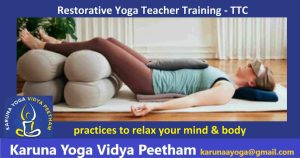Name of the Course: Yoga Nidra Teacher Training Certificate Course
Language: Our courses will be held in English Medium.
Days:Monday – Friday
Timing: 06:00PM – 7:00PM (01 Hours)
Mode:Online
Course Duration:2 Weeks
Total Fee for the Training(For Indian Citizens Only):INR 26,000
Total Fee for the Training(For Non-Indian Citizens Only):USD 390
Accreditation: Yoga Alliance, USA, YACEP.
About the course facilitator: S. Karuna Murthy, M.Sc., Ph.D., E-RYT 500, YACEP
- What you will get?
Yoga Manual (01)
Certificate
Yoga Training
Excluded with accommodation and food
- For Further Consultation: Please Contact Us (karunaayoga@gmail.com or +91 9686549129)
Overview of Yoga Nidra(Yogic Sleep)
Introduction
- Yoga Nidra, often referred to as “yogic sleep,” is a guided meditation practice that induces a state of deep relaxation while maintaining awareness. This powerful technique helps reduce stress, improve sleep quality, and enhance overall well-being. With increasing demand for holistic healing practices, Yoga Nidra has gained widespread popularity among yoga practitioners, wellness professionals, and therapists.

What is Yoga Nidra?
- Yoga Nidra is a systematic method of relaxation that guides individuals through different stages of awareness, ultimately leading to a state between wakefulness and sleep. The practice follows a structured process, including:
Preparation: Finding a comfortable position, usually lying down.
Intention Setting (Sankalpa): Forming a personal resolve or affirmation.
Body Scan: Bringing awareness to different parts of the body to release tension.
Breath Awareness: Observing the natural flow of breath to calm the mind.
Visualization: Using guided imagery to deepen relaxation.
Return to Wakefulness: Gradually regaining full consciousness with awareness.
Highlights
An Online Yoga Nidra Teacher Training Course (TTC) typically covers the following highlights:
1. Foundations of Yoga Nidra
History & origins (Tantra, Vedanta, and modern adaptations)
Scientific research on Yoga Nidra (brain waves, nervous system, benefits)
Understanding consciousness and the stages of sleep
2. Structure & Methodology
Components of a Yoga Nidra session
Step-by-step breakdown of scripts
Role of voice modulation and pacing
Different styles (Satyananda, iRest, Himalayan, etc.)

3. Practical Teaching Skills
How to guide effective Yoga Nidra sessions
Creating scripts for different purposes (relaxation, trauma healing, sleep, manifestation, etc.)
Working with different populations (pregnant women, children, seniors, stressed individuals)
4. Therapeutic Applications
Yoga Nidra for stress, anxiety, PTSD, and sleep disorders
Integrating Yoga Nidra with Yoga Therapy & other healing modalities
Chakra and Sankalpa (intention-setting) practices
5. Personal Practice & Self-Growth
Developing your own Yoga Nidra routine
Journaling & reflection practices
Receiving feedback on teaching Yoga Nidra

6. Certification & Teaching Opportunities
Online or live assessments
Certification (Yoga Alliance Continuing Education or other recognition)
How to integrate Yoga Nidra into regular yoga classes or therapy sessions
Key Aspects of the Training
- Duration & Format – Self-paced or live online sessions, ranging from a few days to several weeks.
- Certification – Yoga Alliance Continuing Education (YACEP) certified.
Who Can Join?
Open to yoga teachers, therapists, psychologists, wellness coaches, or anyone interested in deep relaxation techniques.
What You Will Learn?
1.Philosophy & Science of Yoga Nidra
Origins in Tantra & Vedanta traditions
Effects on brain waves, nervous system, and stress reduction
The role of consciousness and deep relaxation

2.Structure & Methodology
Key components: body scan, breath awareness, Sankalpa (intention-setting), visualization
Different approaches: Satyananda, iRest, Himalayan traditions
Crafting and delivering guided scripts
3.Therapeutic Applications
Yoga Nidra for stress, anxiety, PTSD, trauma recovery, and sleep disorders
Using it as a tool for emotional healing and personal growth
Adapting the practice for various groups (pregnant women, seniors, children, etc.)
Practical Teaching Skills
How to guide an effective Yoga Nidra session
Voice modulation, pacing, and script creation
Ethics and responsibilities of a Yoga Nidra teacher
Self-Practice & Integration
Deepening your own Yoga Nidra practice
How to integrate Yoga Nidra into yoga classes, therapy, or wellness sessions
- 6.Outcome & Benefits
Gain confidence in leading Yoga Nidra sessions
Learn to create customized scripts for different needs
Receive a certification that allows you to teach professionally
Experience personal transformation through deep relaxation techniques
Eligibility
- Yoga Teachers & Instructors
Those with a 200-hour Yoga Teacher Training Certification (YTTC)(not always mandatory)
Looking to add Yoga Nidra to their teaching repertoire
- Yoga Practitioners & Enthusiasts
Individuals with a basic understanding of yoga, meditation, or relaxation techniques
No prior teacher training required for many courses
- Wellness & Healthcare Professionals
Therapists, psychologists, counselors, life coaches, and healthcare providers
Interested in using Yoga Nidra for stress reduction, trauma healing, or therapy
- Mindfulness & Meditation Practitioners
Those practicing or teaching mindfulness, breathwork, or guided meditation
Seeking deeper knowledge in Yoga Nidra as a meditative tool
- Anyone Seeking Personal Growth & Healing
Individuals looking to use Yoga Nidra for self-healing, stress relief, and better sleep
No teaching aspirations required—many join for self-practice
- Are There Any Prerequisites?
- No strict prerequisites for most programs
- No need for advanced yoga asana practice (Yoga Nidra is mostly practiced in Savasana)

Prerequisites
- Most Online Yoga Nidra TTCs have minimal prerequisites, making them accessible to a wide range of individuals. However, some programs may recommend certain foundational knowledge or experience.
Common Prerequisites
- Basic Understanding of Yoga & Meditation (Recommended but not always required)
Familiarity with yoga, breathwork, or relaxation techniques
Prior experience with meditation or mindfulness is beneficial
Interest in Teaching or Personal Growth
Open to yoga teachers, wellness practitioners, or those seeking personal transformation
Some courses may require an intention to guide others in Yoga Nidra
- Good Listening & Communication Skills (For those who want to teach Yoga Nidra)
Ability to guide sessions with a calm and soothing voice
Willingness to develop skills in verbal cueing and script delivery
Optional but Beneficial Prerequisites
- 200-hour Yoga Teacher Training (YTTC) – Some courses prefer participants with prior yoga teaching experience, but it’s not mandatory.
- Experience with Guided Meditation or Relaxation Techniques – Having practiced Yoga Nidra before can be helpful.
- Basic Knowledge of Yoga Philosophy – Understanding concepts like Sankalpa (intention) and Pratyahara (withdrawal of senses) can enhance learning.
No Strict Requirements
- No advanced yoga asana practice required (Yoga Nidra is practiced in Savasana)
- No prior teaching experience needed for beginner-friendly courses
Online Class Requirements
- To successfully participate in an Online Yoga Nidra Teacher Training Course (TTC), you’ll need the following:
1. Technical Requirements
- Stable Internet Connection – Minimum 5 Mbps speed recommended for smooth video streaming
Device – Laptop, desktop, tablet, or smartphone (laptop/desktop preferred for better experience)
Video Conferencing Platform – Zoom, Google Meet, or a course porta
Headphones/Earphones – For better sound clarity, especially for guided Yoga Nidra sessions
Quiet Space – A distraction-free environment for live sessions and practice
2. Study Materials & Tools
- Course Manual/PDFs – Provided by most schools as downloadable resources
Notebook & Pen – For journaling, script writing, and personal reflection
Recording App/Software – Useful for practicing and reviewing your own Yoga Nidra scripts
3. Physical & Mental Readiness
- Comfortable Space for Practice – A yoga mat, pillow, and blanket for relaxation
Open Mind & Willingness to Learn – No physical postures needed, but deep listening and introspection are key - Time Commitment – Courses range from self-paced to live sessions with assignments (usually 10-30 hours)
Syllabus
- A Yoga Nidra TTC syllabus typically covers philosophy, methodology, script development, and teaching skills. Below is a structured outline of what you can expect in most courses:
MODULE 1: Introduction to Yoga Nidra
Definition and meaning of Yoga Nidra
Origins: Tantra, Vedanta, and modern influences
Yoga Nidra vs. Hypnosis vs. Meditation
Scientific research on brain waves (Alpha, Theta, Delta states)
The effects of Yoga Nidra on the nervous system (Parasympathetic activation)
MODULE 2: Theory & Philosophy
States of consciousness (waking, dreaming, deep sleep, Turiya)
The five koshas (layers of existence) & their relation to Yoga Nidra
Yoga Nidra & Pratyahara (withdrawal of senses)
Sankalpa (intention-setting) and its transformative power
MODULE 3: Philosophy & Yogic Psychology
The Five Koshas (layers of being)and their relation to Yoga Nidra
Yoga Nidra and the states of consciousness(waking, dreaming, deep sleep, Turiya)
The role of Pratyahara (withdrawal of senses)in deep relaxation
The concept of Sankalpa (intention-setting)and how to use it effectively
MODULE 4: Structure & Components of Yoga Nidra
- The 8-Stage Framework of Yoga Nidra
Settling & Relaxation– Preparing the body and mind for stillness
Sankalpa (Intention Setting)– Creating positive subconscious imprints
Rotation of Consciousness (Body Scan)– Systematic relaxation of the body
Breath Awareness & Pranic Flow– Cultivating subtle energy awareness
Opposite Sensations– Emotional balancing through contrast
Guided Visualization– Engaging the subconscious for deep transformation
Sankalpa Reaffirmation– Strengthening personal intentions
Reintegration & Awakening– Returning to full awareness
MODULE 5: Structure & Methodology of Yoga Nidra
- The 8-Stage Framework of Yoga Nidra
Settling & Relaxation(Body positioning, breath awareness)
Sankalpa (Intention Setting)
Body Scan (Rotation of Consciousness)
Breath Awareness & Prana Flow
Opposite Sensations (Balancing Emotions)
Guided Visualization
Sankalpa Reaffirmation
Reintegration & Awakening
Understanding different styles:
- Satyananda Tradition (Classical Yoga Nidra)
- Himalayan Tradition & Other Modern Approaches
MODULE 6: Voice Modulation & Script Development
How to create effective Yoga Nidra scripts
Using tone, pacing, and pauses for deeper relaxation
Adapting scripts for different audiences (general relaxation, sleep, stress relief, trauma healing, etc.)
Developing a calm, steady, and soothing voice
Importance of pacing, tone, and pauses
Adapting language for different audiences (therapeutic, general relaxation, spiritual, etc.)
The art of holding space for deep relaxation
MODULE 7: Therapeutic Applications of Yoga Nidra
Yoga Nidra for stress, anxiety, trauma, PTSD, sleep disorders
The role of Yoga Nidra in emotional healing & subconscious reprogramming
Adaptations for special groups:
- Pregnant women
- Children
- Seniors
- People with chronic stress or mental health concerns
MODULE 8: Script Development & Customization
Writing your own Yoga Nidra scripts
Crafting theme-based sessions(stress relief, sleep, emotional healing, creativity, etc.)
MODULE 9: Teaching Methodology & Practicum
How to guide Yoga Nidra sessionsconfidently
Ethical considerations and responsibilities of a Yoga Nidra teacher
Recording and self-assessment of your teaching
Live practice sessions with feedback
MODULE 10: Certification & Final Assessment
Teaching practicum: guiding a Yoga Nidra session
Written or practical evaluation
Certificate upon successful completion
- Learning Outcomes & Benefits
- Gain mastery in guiding Yoga Nidra for relaxation & therapy
Learn to create and modify scripts for different needs
Develop a soothing and effective teaching voice
Understand the science and philosophy behind the practice
Receive certification to teach Yoga Nidra professionally
Recommended Books
1.”Yoga Nidra” – Swami Satyananda Saraswati
2.”The Art of Yoga Nidra” – Andre Riehl
3.”Yoga Nidra: The Art of Transformational Sleep” – Kamini Desai
4.”Yoga Nidra for Complete Relaxation and Stress Relief” – Julie Lusk
6.”Radiant Rest: Yoga Nidra for Deep Relaxation and Awakened Clarity” – Tracee Stanley
7.”Daring to Rest: Reclaim Your Power with Yoga Nidra Rest Meditation” – Karen Brody
8.”Deep Relaxation: Yoga Nidra Made Easy” – Pierre Bonnasse
9.”The Upanishads” – Translation by Eknath Easwaran
10.”The Power of Your Subconscious Mind” – Joseph Murphy
(FAQ)Frequently Asked Questions
1.What is Yoga Nidra?
- Yoga Nidra is a guided meditation technique that induces deep relaxation while maintaining awareness. It helps release stress, improves sleep, and promotes healing.
2.Who can take an Online Yoga Nidra TTC?
Yoga teachers (with or without prior TTC experience)
Meditation practitioners & wellness coaches
Therapists, psychologists, and healthcare professionals
Anyone seeking deep relaxation & personal transformation
There are no strict prerequisites, but having a basic understanding of yoga or meditation is helpful.
3.Do I need a 200-hour Yoga Teacher Training (YTTC) to join?
No, a 200-hour YTTC is not mandatory for most courses. However, if you want to certify with Yoga Alliance, you may need a YTTC background.
4. What are the technical requirements for online training?
- A stable internet connection (minimum 5 Mbps for smooth streaming)
A laptop, desktop, tablet, or smartphone
Headphones/earphones for clear audio
A quiet space for practice
5. How long does an Online Yoga Nidra TTC take?
- Courses vary depending on the school:
Short courses: 20-30 hours (1-2 weeks, self-paced or live)
Comprehensive courses: 50+ hours (3-6 weeks)
Some programs are self-paced, while others require attendance in live sessions
6. Is Yoga Nidra the same as hypnosis or sleep?
- No, Yoga Nidra is different from hypnosis or sleep.
It guides you into a state between waking and sleeping, where deep relaxation and subconscious reprogramming happen.
Unlike hypnosis, Yoga Nidra does not involve external suggestionsbut rather self-awareness and Sankalpa (intention-setting).
7.What certification will I receive after the course?
Most Yoga Nidra TTCsprovide a completion certificate.
Some are Yoga Alliance Continuing Education Provider (YACEP)certified (for RYTs needing continuing education hours).
Check with your school to confirm certification details.
8.Can I teach Yoga Nidra after completing this course?
- Yes, after certification, you can lead Yoga Nidra sessions in yoga studios, wellness centers, or online.
You can integrate it into yoga classes, meditation sessions, or therapy practices.
Some courses focus on personal growth, while others are designed to help you become a certified Yoga Nidra instructor.
9.What are the benefits of Yoga Nidra?
- Yoga Nidra helps with:
Deep relaxation and stress relief
Improved sleep & insomnia relief
Emotional healing & trauma recovery
Mental clarity & creativity enhancement
Balancing the nervous system & reducing anxiety
10.Where can I find the best Online Yoga Nidra TTC?
There are many great schools offering online Yoga Nidra TTCs. Some well-known ones include:
Bihar School of Yoga (Satyananda Yoga Nidra)
Karuna Yoga Vidya Peetham, Bangalore, India. www.karunayoga.in
iRest Yoga Nidra (Richard Miller’s approach, great for therapy & PTSD)
Himalayan Yoga Tradition
Online platforms like Yoga International, My Vinyasa Practice, and Yoga Alliance-certified schools

